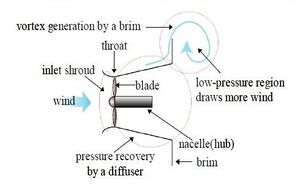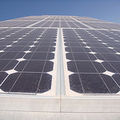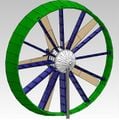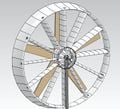Open Wind Lens (OWL): Wind Turbine modified prototype[edit | edit source]
Background[edit | edit source]
There is an increasingly big necessity to supply the huge energy demand in the World, but also Environmental Protection is a crucial aspect. Considering that the Humanity and rest of living beings directly depend on the Planet's condition. Nowadays, the challenge is to ensure energy security through sustainable, feasible and accessible options.
Among the areas of interest include:
- Biomass
- Wind
- Solar
- Shale gas
- Cellulosic ethanol
- Geothermal
-
Fig 1: Waiaraki Geothermal Power Station, Taupo New Zealand
-
Fig 2: Solar Panel
-
Fig 3: Eolic Energy
For the purpose of this material, the principal area is Wind.
Wind Energy[edit | edit source]
You would think that the production of energy from wind has a number of complications in terms of air flow, wind direction, and the costs of equipment, maintenance, or even problems for gaseous pollutants, among others. However, wind energy is really advantageous under the right conditions.
Over time, wind has always been used as an energy source and today has been considered as a significant source of energy due to its accessibility and low cost comparing to other sources of energy as cellulosic ethanol at the present time. Furthermore, the power obtained depends significantly on the wind speed.
Proposal[edit | edit source]
Imitating the engineering of jet engines and considering Bernoulli's principle, performance can be significantly improved. As a wind lens, the hoop structure which surrounds the blades diverts air away from the exhaust outflow behind the blades. The turbulence generated create a low pressure zone behind the turbine, causing greater wind to pass through the turbine instead of being an obstruction of air flow. Causing a faster rotating speed, and also significant increase in its power output. (Video about how the wind lens concept works)

Description[edit | edit source]
Open Wind lens it is an alternative for increased efficiency-per-area, blade safety and reduced noise in comparison to the conventional design of wind turbines. It is a 3D printing model that can increase power output 2-5 times, depending how well the shroud is designed.
-
Fig 5: OWL
-
Fig 6: Close up, Open Wind Lens
Blades are around 1 m diameter in consideration as a good safety margin of strength and make construction easily manageable for a very small team. The structure is designed to accept up to a 35 mm diameter pole.
-
Fig 7: Structure with a 35 mm diameter pole
The design is inspired by Hugh Piggott's "Wind Turbine Recipe Book", 2009 metric edition, and FloDesign's concept designs.
It is important to consider that this project is still a work in progress.
Applications[edit | edit source]
It could be the energy source needed for low-power applications in home, really accesible and versatile considering that it is intented to work in a wide operational range of wind speed.
In a large scale, a massive wind lens power plant could be the energy source of an entire region or country depending on the output power and favorable conditions.
References:
- https://www.appropedia.org/Energy
- http://en.wikipedia.org/wiki/Energy_security
- http://en.wikipedia.org/wiki/Wind_lens
- Open Wind lens, published on August 4th, 2012.
- Bernoulli's principle
- Video about how the wind lens concept works
- A Shrouded Wind Turbine Generating High Output Power with Wind-lens Technology, by Yuji Ohya and Takashi Karasudani. Open Access.
- Hugh Piggott's "Wind Turbine Recipe Book", 2009 metric edition.
- New wind Turbine FloDesign





